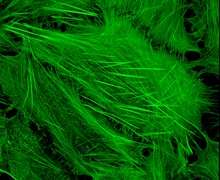Cytoskeletal drugs
Cytoskeletal drugs are small molecules that interact with actin or tubulin. These drugs can act on the cytoskeletal components within a cell in three main ways. Some cytoskeletal drugs stabilize a component of the cytoskeleton, such as taxol which stabilized microtubules or Phalloidin which stabilizes actin filaments. Others such as Cytochalasin D bind to actin monomers and prevent them from polymerizing into filaments. Drugs such as demecolcine act by enhancing the depolymerisation of already formed filaments. Some of these drugs have multiple effects on the cytoskeleton, for example Latrunculin both prevents actin polymerization as well as enhancing its rate of depolyermisation. Typically the microtubule targeting drugs can be found in the clinic where they are used therapeutically in the treatment of some forms of cancer.[1] As a result of the lack of specificity for specific type of actin (i.e. cannot distinguish between cardiac, smooth muscle, muscle and cytoskeletal forms of actin) the use of these drugs in animals results in unacceptable off target effects. Despite this the actin targeting compounds are still useful tools that can be used on a cellular level to help further our understanding of how this complex part of the cells internal machinery operates. For example, Phalloidin which has been conjugated with a fluorescent probe can be used for visualizing the filamentous actin in fixed samples.

| Drug Name | Target cytoskeletal component | Effect | Clinical applications |
|---|---|---|---|
| Colchicine[2] | microtubules | prevents polymerization | Used to treat gout |
| Cytochalasins[3] | actin | prevents polymerization | none |
| Demecolcine[4] | microtubules | depolymerizes | chemotherapy |
| Latrunculin[5] | actin | prevent polymerization, enhance depolymerisation | none |
| Jasplakinolide[6][7] | actin | enhances polymerization | none |
| Nocodazole[8] | microtubules | prevents polymerization | none |
| Paclitaxel (taxol)[9] | microtubules | stabilizes microtubules and therefore prevents mitosis | chemotherarpy |
| Phalloidin[10] | actin | stabilizes filaments | none |
| Swinholide[11] | actin | sequesters actin dimers | none |
| Vinblastine[1] | microtubules | prevents polymerization | chemotherapy |
See also
References
- 1 2 Jordan, M. A.; Leslie, W. (2004). "Microtubules as a Target for Anticancer Drugs". Nature Reviews Cancer. 4 (4): 253–265. doi:10.1038/nrc1317. PMID 15057285.
- ↑ Vandecandelaere, A; Martin, S R; Engelborghs, Y (April 1, 1997). "Response of microtubules to the addition of colchicine and tubulin-colchicine: evaluation of models for the interaction of drugs with microtubules". Biochem J. 323 (Pt 1): 189–196. PMC 1218294
 . PMID 9173881.
. PMID 9173881. - ↑ Cooper, J. A. (1987). "Effects of Cytochalasin and Phalloidin on Actin" (pdf). Journal of Cell Biology. 105 (4): 1473–1478. doi:10.1083/jcb.105.4.1473. PMC 2114638
 . PMID 3312229.
. PMID 3312229. - ↑ Jordan, Mary Ann; Wilson, Leslie (2004). "Microtubules as a target for anticancer drugs". Nature reviews. Cancer. 4 (4): 253–65. doi:10.1038/nrc1317. PMID 15057285.
- ↑ Yarmola, E.G.; Somasundaram, T.; Boring, T.A.; Spector, I.; Bubb, M.R. (2000). "Actin-Latrunculin A Structure and Function". Journal of Biological Chemistry. 275 (36): 28120–28127. doi:10.1074/jbc.M004253200. PMID 10859320.
- ↑ Sasse, F; Kunze, B; Gronewold, TM; Reichenbach, H (Oct 21, 1998). "The chondramides: cytostatic agents from myxobacteria acting on the actin cytoskeleton.". Journal of the National Cancer Institute. 90 (20): 1559–63. doi:10.1093/jnci/90.20.1559. PMID 9790549.
- ↑ Bubb, Michael R.; Spector I.; Beyer B.B.; Fosen K.M. (2000). "Effects of Jasplakinolide on the Kinetics of Actin Polymerization". J Biol Chem. 275 (7): 5163–70. doi:10.1074/jbc.275.7.5163. PMID 10671562.
- ↑ Vasquez, R.J.; et al. (1997). "Nanomolar concentrations of nocodazole alter microtubule dynamic instability in vivo and in vitro". Mol. Biol. Cell. 8: 973–985. doi:10.1091/mbc.8.6.973.
- ↑ Wani M, Taylor H, Wall M, Coggon P, McPhail A (1971). "Plant antitumor agents. VI. The isolation and structure of taxol, a novel antileukemic and antitumor agent from Taxus brevifolia". J Am Chem Soc. 93 (9): 2325–7. doi:10.1021/ja00738a045. PMID 5553076.
- ↑ Buchwalow, Igor B.; Böcker, Werner (2010). Immunohistochemistry: Basics and Methods. Springer,. p. 92. ISBN 978-3-642-04608-7.
- ↑ Bubb, MR; Spector, I; Bershadsky, AD; Korn, ED (1995). "Swinholide a is a microfilament disrupting marine toxin that stabilizes actin dimers and severs actin filaments". The Journal of Biological Chemistry. 270 (8): 3463–6. doi:10.1074/jbc.270.8.3463. PMID 7876075.